In recent years, more people are turning to raised garden beds for their outdoor spaces. These versatile setups are perfect for urban and suburban areas, offering a practical solution for growing plants. Whether you’re a seasoned gardener or a beginner, raised beds provide numerous advantages, from better soil control to easier maintenance.
Many gardeners, like my mother, have switched from traditional in-ground planting to raised beds. She found them more manageable and productive. This guide will walk you through everything you need to know—benefits, design ideas, step-by-step building instructions, and maintenance tips.
We’ll also explore resources like the Kitchen Garden Revival book and the Kitchen Garden Academy course. Expect actionable advice, including seasonal care and customization options to suit your needs.
Key Takeaways
- Raised garden beds are ideal for urban and suburban spaces.
- They offer better soil control and easier maintenance.
- This guide covers benefits, designs, building steps, and care tips.
- Resources like Kitchen Garden Revival can enhance your gardening journey.
- Customization options make raised beds adaptable to any space.
Introduction to Raised Backyard Gardens
Elevated planting areas are transforming how we grow plants at home. These structured setups, often called raised garden beds, are framed soil containers that sit above ground level. They’re perfect for those who want a more organized and efficient way to cultivate their favorite greens.
Compared to traditional in-ground methods, raised beds are like night and day. They allow you to control the soil quality, making it easier to grow healthy plants. This is especially helpful if your native ground soil is poor or compacted.
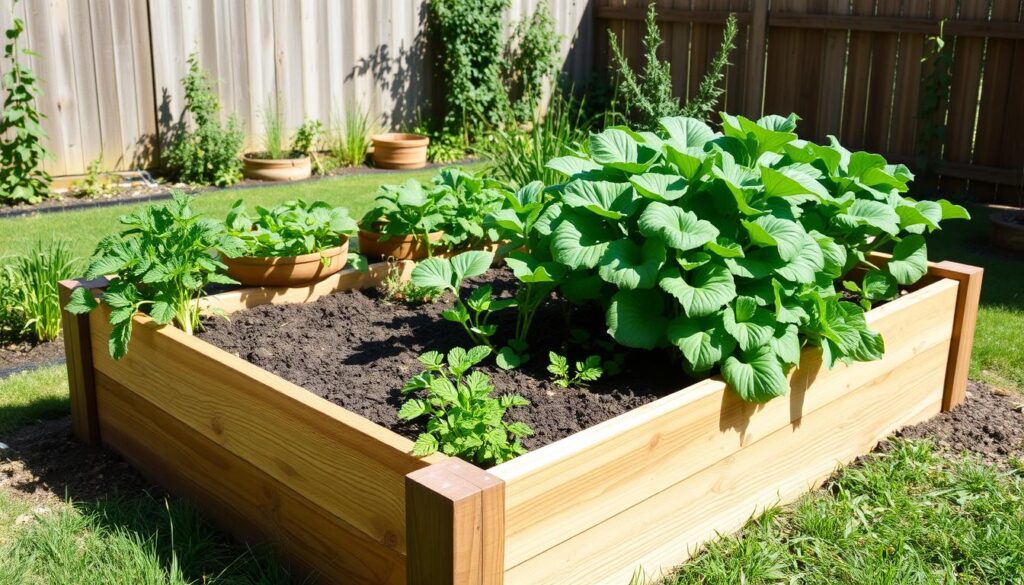
These beds are ideal for various scenarios. If you have limited mobility, the elevated design reduces bending and kneeling. Small space? No problem. Raised beds can fit on patios, slopes, or even rooftops. Their flexibility in size and placement makes them a versatile choice for any home.
“With raised beds, you can start planting immediately, even if the ground soil is still frozen.”
This immediate planting advantage is a game-changer for gardening enthusiasts. Instead of waiting for the ground to thaw, you can get a head start on your growing season. Whether you’re a beginner or an experienced gardener, raised beds offer a practical and rewarding way to grow your plants.
Benefits of a Raised Backyard Garden
Customizing your growing environment is easier with structured planting setups. These systems offer several advantages, from improved soil quality to better water management. Whether you’re growing vegetables or flowers, these benefits can make a big difference in your gardening success.
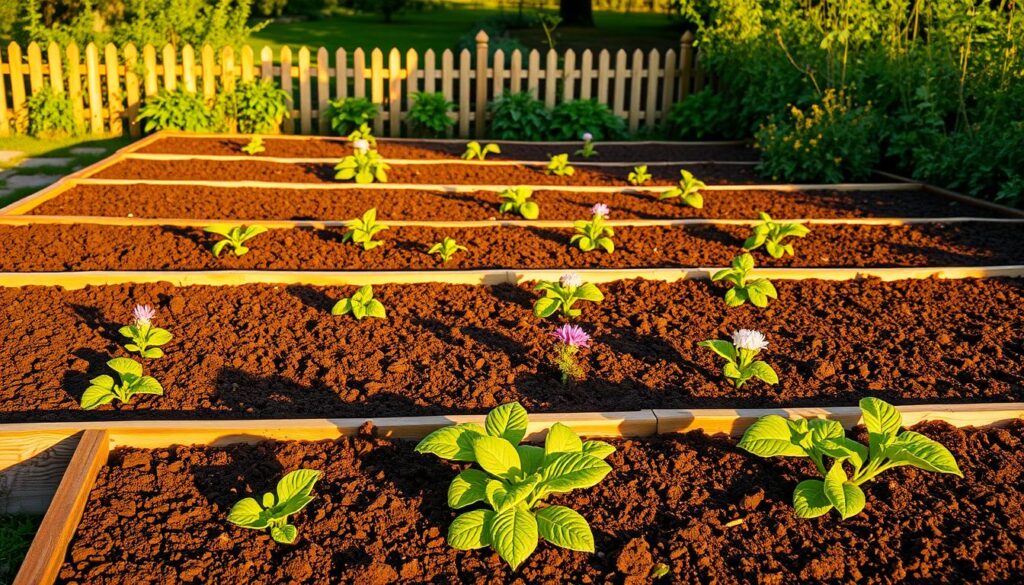
Better Soil Control
One of the biggest perks is the ability to manage your soil. You can create a mix tailored to your plants’ needs, like adding compost for extra nutrients. This is especially helpful for crops like carrots and tomatoes, which thrive in loose, well-aerated soil.
Unlike ground-level planting, these setups reduce soil compaction. This allows plants roots to grow deeper and stronger. Plus, you avoid the risk of contamination from poor native soil.
Enhanced Drainage
Another advantage is improved drainage. Elevated designs prevent waterlogging, which is crucial for root vegetables like radishes. Excess water drains away, keeping the soil healthy and reducing the risk of rot.
This setup also minimizes soil erosion. Water flows evenly, protecting your plants from damage. For seniors or those with physical limitations, the accessibility of these systems is a game-changer.
“With better soil and drainage, your plants will thrive, even in challenging conditions.”
These benefits make structured planting setups a smart choice for any gardener. Whether you’re a beginner or an expert, you’ll appreciate the control and convenience they offer.
Design Ideas for Your Raised Backyard Garden
Designing your outdoor space with structured planting setups can elevate both aesthetics and functionality. Whether you prefer classic or modern styles, there are plenty of options to suit your needs. Let’s explore some popular types of designs to inspire your next project.

Traditional Wooden Beds
Wooden beds are a timeless choice for structured planting areas. Cedar and redwood are popular due to their natural rot resistance, making them durable for outdoor use. However, these materials can be costly.
For a budget-friendly option, consider pine. While not as long-lasting as cedar, pine is more affordable and works well for short-term projects. When choosing lumber, ensure it’s untreated to avoid chemicals that could harm your plants.
Modern Metal and Composite Beds
If you’re looking for a sleek, low-maintenance option, metal and composite beds are excellent choices. Galvanized steel offers rust resistance, while recycled plastic composites are eco-friendly and durable.
These modern designs are perfect for urban spaces or those who prefer a minimalist look. Pre-built kits, like those from Home Depot, provide convenience and a variety of styles to choose from.
When planning your setup, aim for a minimum height of 6 inches to ensure proper root depth. Whether you opt for DIY or pre-built kits, structured planting areas offer endless possibilities for creativity and efficiency.
How to Build a Raised Backyard Garden
Building your own planting area is a rewarding DIY project that combines creativity and practicality. Whether you’re a seasoned DIY enthusiast or a beginner, this step-by-step guide will help you create a functional and beautiful space for your plants.
Choosing the Right Location
Start by selecting a spot that gets at least six hours of sunlight daily. This is crucial for growing healthy vegetables. Avoid areas with heavy shade or poor drainage. A flat surface is ideal, but you can also build on a slope with proper leveling.
Gathering Tools and Materials
Before you begin, gather all the necessary tools and materials. Here’s a list of what you’ll need:
| Tools | Materials |
|---|---|
| Miter saw | 2×4 lumber (for a 4x6x10.5″ bed) |
| Drill | Hardware cloth |
| Shovel | Plastic lining |
Hardware cloth prevents weeds, while plastic lining protects untreated wood from moisture. These materials ensure your planting area stays durable and weed-free.
Constructing the Bed Frame
Cut the 2x4s to the desired length using a miter saw. Assemble the frame by attaching the boards with corner posts. Use a drill to secure the joints. Ensure the frame is level and sturdy before moving to the next step.
Preparing the Soil and Planting
Mix 60% topsoil, 30% compost, and 10% perlite for a nutrient-rich blend. Fill the frame with this mixture, leaving a few inches at the top. When planting, break up root balls and leave enough space for mature plants to grow.
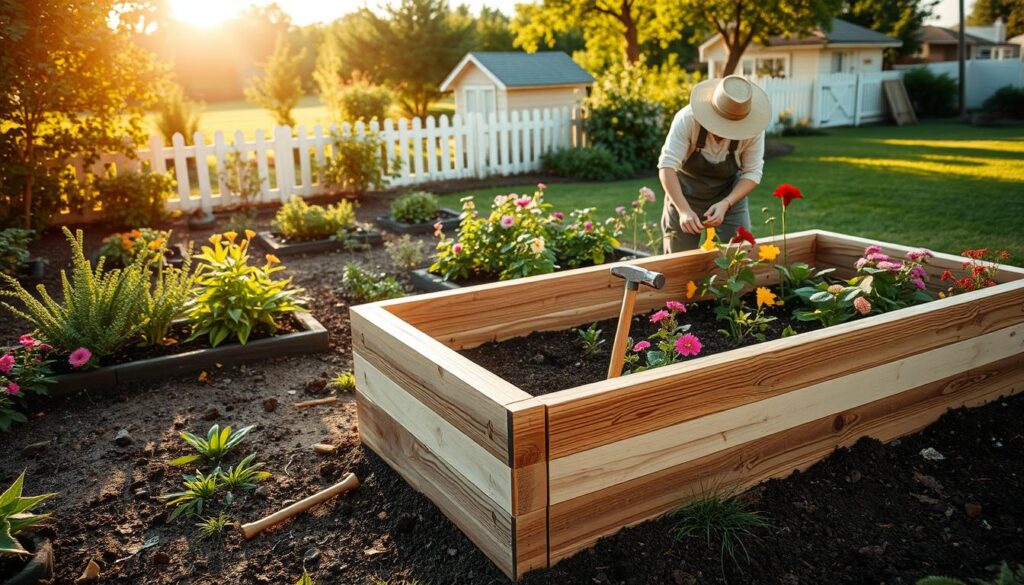
With these steps, you’ll have a functional and attractive planting area ready for your favorite vegetables and plants. Enjoy the process and the fruits of your labor!
Maintaining Your Raised Backyard Garden
Keeping your plants healthy and thriving requires consistent care and attention. Proper maintenance ensures they grow strong and produce a bountiful harvest. Let’s explore the essential steps to keep your setup in top shape.
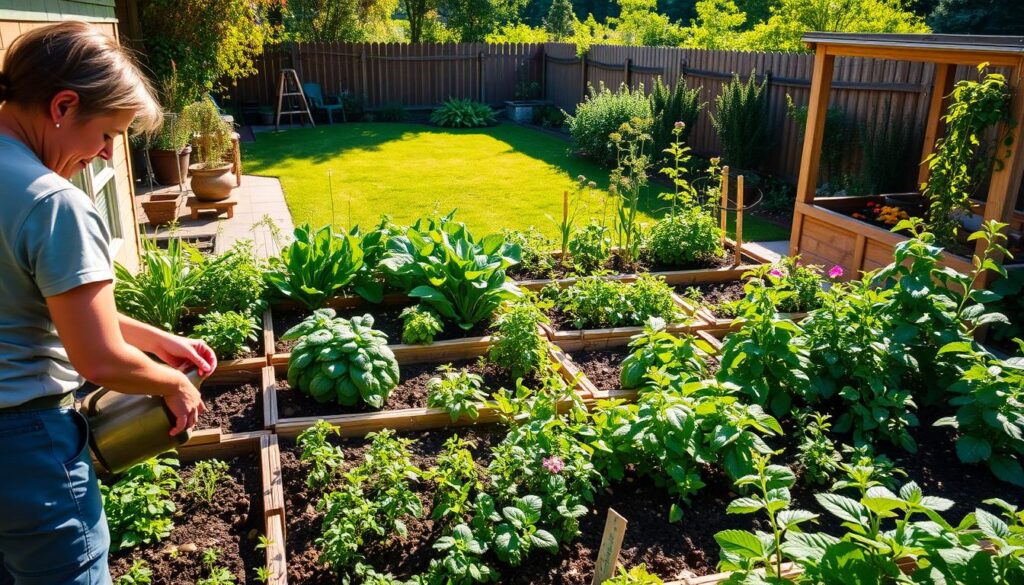
Watering and Fertilizing
Consistent watering is crucial for plant health. Drip irrigation systems or soaker hoses with timers are excellent tools. They deliver water directly to the roots, reducing waste and ensuring even moisture. Morning is the best time to water, as it allows plants to absorb moisture before the heat of the day.
For fertilizing, organic options like fish emulsion work wonders. Apply it every four weeks to provide essential nutrients. This schedule keeps your plants nourished without overloading the soil.
Weed and Pest Control
Effective weed control starts with mulching. A layer of mulch suppresses weeds and retains soil moisture. For pests, natural solutions like neem oil or companion planting are safe and effective. Marigolds, for example, deter nematodes naturally.
“Healthy plants are less likely to attract pests, so focus on creating a balanced environment.”
For more tips on starting your journey, check out this guide on gardening for beginners.
Raised Backyard Garden Layout Tips
Planning your outdoor planting area strategically can significantly boost plant health and yield. A well-thought-out layout ensures your plants get the right amount of sunlight, proper spacing, and beneficial pairings. Here’s how to optimize your setup for maximum success.
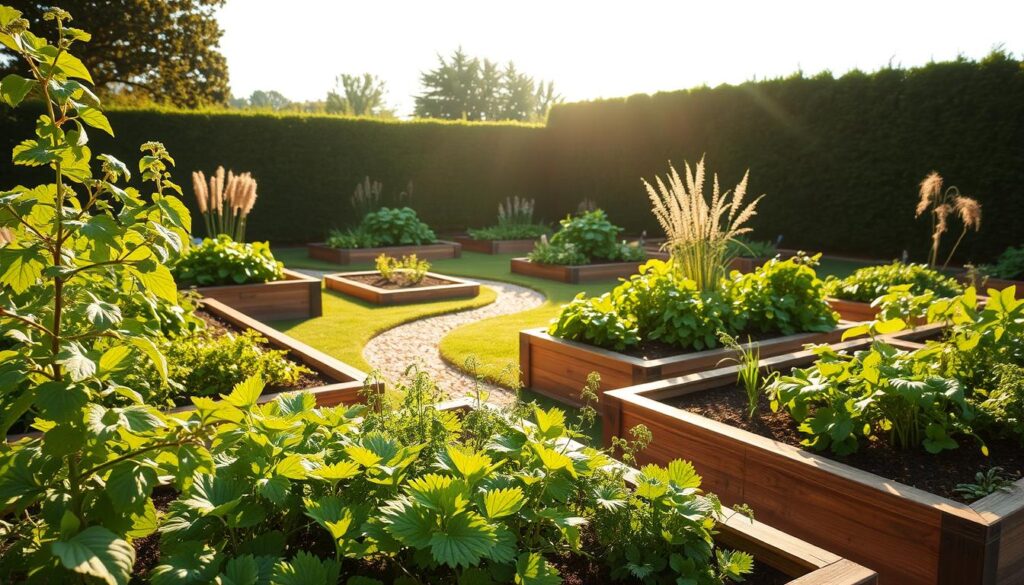
Plant Placement for Sunlight
Sunlight is essential for healthy growth. Position your beds north-to-south to ensure even light distribution throughout the day. Tall plants like tomatoes should go at the back, while sprawling crops like cucumbers can be placed at the edges. This arrangement prevents shading and allows all plants to thrive.
For small spaces, consider square-foot gardening. This method maximizes yield by dividing the area into sections, each dedicated to specific vegetables or flowers. It’s a great way to make the most of limited room.
Companion Planting
Companion planting is a smart way to enhance growth and deter pests naturally. Pair basil with tomatoes to improve flavor and repel insects. Nasturtiums planted near squash can deter aphids and add a pop of color to your setup.
Vertical gardening is another space-saving technique. Add trellises for beans or peas to grow upward, freeing up ground space for other plants. This approach is ideal for urban settings or small patios.
“Strategic plant placement and companion planting can transform your outdoor area into a thriving ecosystem.”
With these tips, you’ll create a functional and beautiful planting area that maximizes sunlight, space, and plant health. Happy gardening!
Seasonal Care for Your Raised Garden
Taking care of your planting area throughout the year ensures healthy growth and a bountiful harvest. Each season brings unique tasks that keep your plants thriving. From preparing the soil in spring to insulating beds in winter, here’s how to maintain your setup year-round.
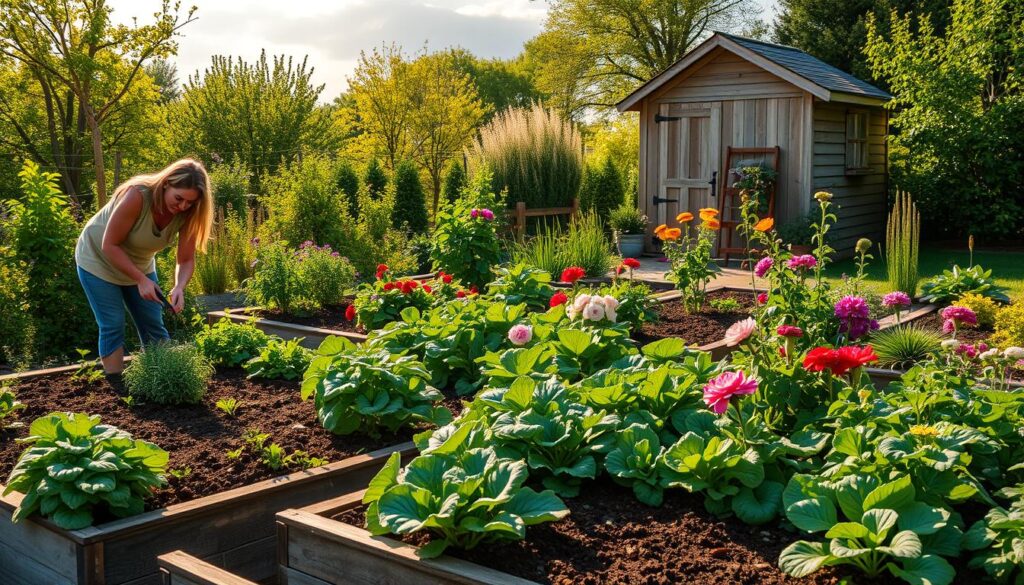
Spring and Summer Gardening
In spring, start with cool-weather crops like lettuce and peas. Test your soil’s pH to ensure it’s balanced for planting. Adding compost between cycles replenishes nutrients, giving your plants a strong start.
As summer arrives, mulch becomes essential. It retains moisture and keeps the soil cool during hot days. Stake heavy fruiting plants like tomatoes to prevent them from toppling over. Regular watering and monitoring for pests will keep your plants healthy.
Fall and Winter Preparation
When fall begins, plant garlic or cover crops to protect the soil. Remove spent plants to prevent diseases from lingering. Cold frames or row covers can extend the growing season, allowing you to harvest longer.
In winter, insulate your beds with straw or burlap if you live in freezing climates. This protects the soil structure and prepares it for the next planting season. Even in colder months, a little care goes a long way.
“Seasonal care ensures your planting area remains productive and ready for the next cycle.”
By following these tips, you’ll keep your plants healthy and your setup in top shape all year long. Happy gardening!
Raised Backyard Garden Kits
Ready-to-use solutions are gaining popularity among gardening enthusiasts. These bed kits offer a convenient way to create structured planting areas without the hassle of sourcing materials or planning a diy project. Whether you’re short on time or new to gardening, kits provide a streamlined approach to building your green space.
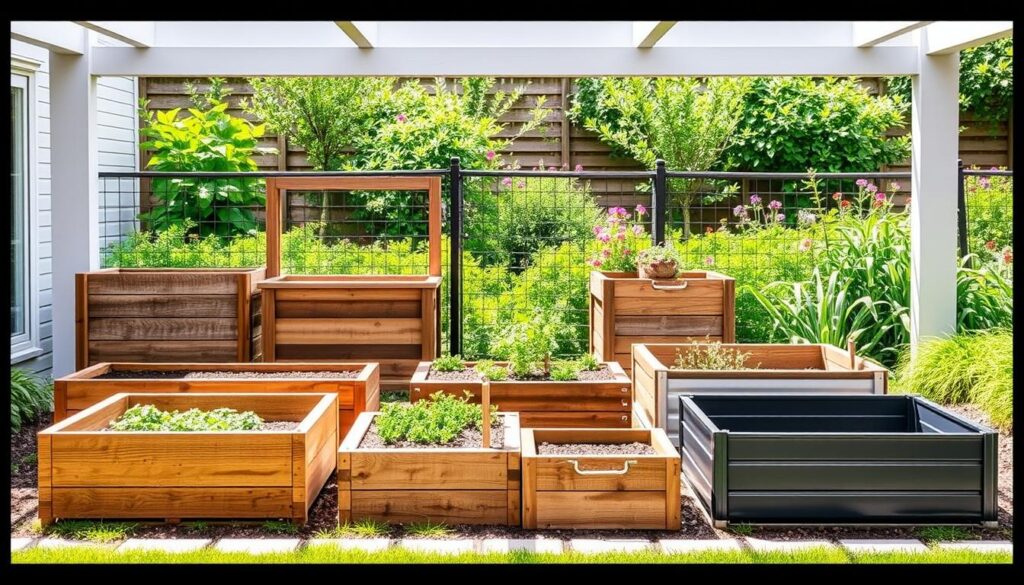
Pros and Cons of Kits
One of the biggest advantages of using kits is their time-saving nature. Most kits come pre-cut and ready to assemble, often taking less than two hours to set up. They’re perfect for those who want a quick start without the complexity of a diy build.
However, kits do have limitations. Customization options are often restricted, which can be a drawback for those with specific design preferences. Additionally, while kits are convenient, they may not always match the durability of a fully custom-built setup.
“Kits are a great option for beginners or anyone looking for a hassle-free solution.”
Top Kit Recommendations
If you’re considering a kit, here are some popular options to explore:
- Greenes Fence Cedar Kit: Known for its durability and natural look, this cedar kit is a favorite among gardeners.
- Yaheetech Metal Kit: A sleek, rust-resistant option that’s perfect for modern outdoor spaces.
- Vego Garden Modular Kit: Offers flexibility with its modular design, allowing you to expand as needed.
Prices for these kits range from $150 to $500+, depending on size and materials. While they may require a higher upfront investment, the convenience and ease of assembly make them a worthwhile choice for many.
Customizing Your Raised Garden
Adding functional and aesthetic elements to your setup enhances both beauty and practicality. Whether you’re growing vining plants or creating a cozy outdoor retreat, customization can make your space truly unique. Let’s explore some creative ideas to elevate your landscape.
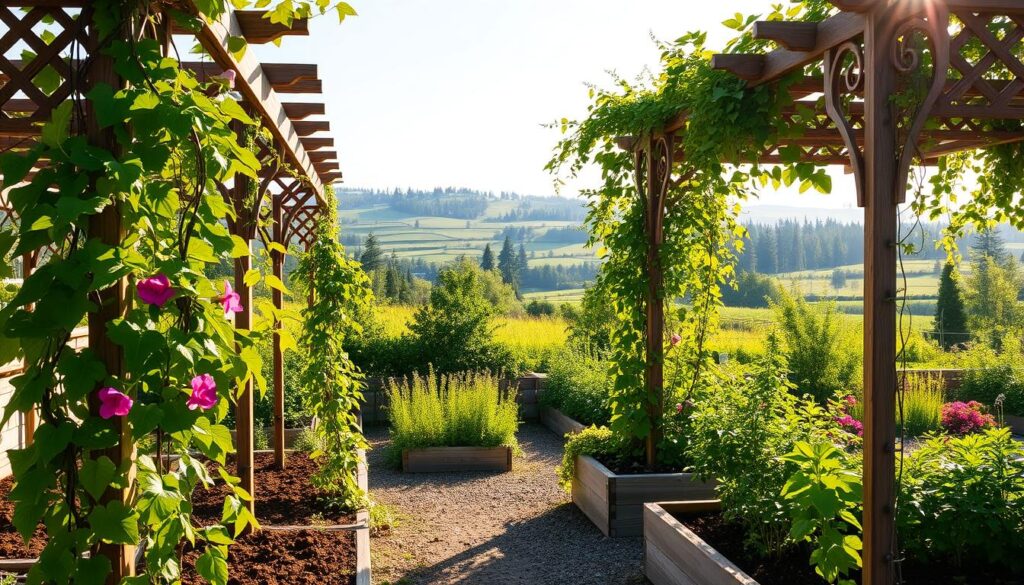
Adding Trellises and Supports
Trellises are a great way to support vining plants like cucumbers, beans, and tomatoes. They save space and keep plants healthy by improving air circulation. PVC or wooden trellises are durable options, while mesh covers can deter pests effectively.
For a DIY approach, consider using cattle panels or bamboo teepees. These materials are affordable and easy to install. They also add a rustic charm to your outdoor area.
Decorative Elements
Enhance the visual appeal of your setup with decorative elements. Painted bed borders or engraved signage can add a personal touch. Pea gravel or stone borders integrate seamlessly with patio designs, creating a cohesive look.
For larger setups, consider adding bench seating around the edges. This not only provides a functional space to relax but also makes your area more inviting.
| Customization Idea | Benefits |
|---|---|
| Trellises | Supports vining plants, saves space |
| Painted Borders | Adds color and personality |
| Bench Seating | Provides functional relaxation space |
“Customizing your outdoor space not only improves functionality but also reflects your personal style.”
With these ideas, you can transform your planting area into a standout feature of your home. Whether you’re adding trellises or decorative touches, the possibilities are endless.
Conclusion
Creating a thriving outdoor space is easier than ever with structured planting setups. These systems offer better soil control, improved accessibility, and higher yields, making them a smart choice for any gardener. Whether you’re growing vegetables or flowers, the benefits are undeniable.
For more guidance, explore resources like Gardenary or consult local experts. They can provide tailored advice to help you succeed. If you’re new to this, start small with a 4×4 bed and expand as your confidence grows.
With the right tools and knowledge, you can start growing your dream garden today. Happy planting!

